OF COMPOST, MICROWAVES, AND BLUEBERRIES
Manure Unnecessary
Manure or not, it’s compost time. I like to make enough compost through summer so that it can get cooking before autumn’s cold weather sets in. Come spring, I give the pile one turn and by the midsummer the black gold is ready to slather onto vegetable beds or beneath choice trees and shrubs.
I haven’t gotten around to getting some manure for awhile so I just went ahead this morning and started building a new pile without manure. It’s true: You do not need manure to make compost. Any pile of organic materials will decompose into compost given enough time.

My piles are a little more deliberate than mere heaps of organic materials. For one thing, everything goes into square bins each about 4′ on a side and built up, along with the materials within, Lincoln-log style from notched 1 x 6 manufactured wood decking. Another nice feature of this system is that the compost is easy to pitchfork out of the pile as sidewalls are removed with the lowering compost.
My main compost ingredient is hay that I scythe from an adjoining field. As this material is layered and watered into the bin it also gets sprinkled regularly with some soil and limestone. Soil adds some bulk to the finished material. The limestone adds alkalinity to offset the naturally increasing acidity of many soils here in the Northeast. Into the pile also goes any and all garden and kitchen refuse whenever available.
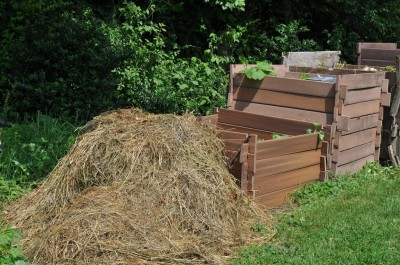
What manure adds to a compost pile is bedding, usually straw or wood shavings, and what comes out of the rear end of the animal. The latter is useful for providing nitrogen to balance out the high carbon content of older plant material in the compost, such as my hay.
But manure isn’t the only possible source of nitrogen. Young, green, lush plants are also high in nitrogen, as are kitchen trimmings, hair, and feathers. Soybean meal, or some other seed meal, is another convenient source.
Compost piles fed mostly kitchen trimmings or young plants benefit from high carbon materials. Otherwise, these piles become too aromatic, not positively.
As I wrote above, “Any pile of organic materials will decompose into compost given enough time.” Nitrogen speeds up decomposition of high carbon compost piles, enough to shoot temperatures in the innards of the pile to 150° or higher. All that heat isn’t absolutely necessary but does kill off most pests, including weed seeds, quicker than slow cooking compost piles.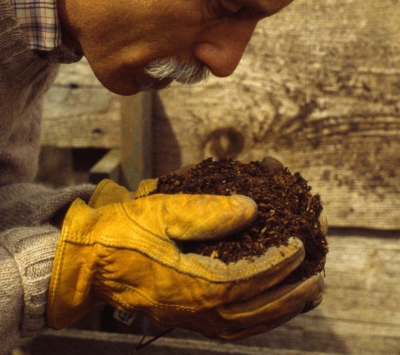
Plus, it’s fun nurturing my compost pets, the microorganisms that enjoy life within a compost pile.
Novel Use for Microwave
I bought my first (and only) microwave oven a few years ago ($25 on craigslist) and have cooked up many batches of soil in it. You thought I was going to use it to cook food? Nah.
Usually, I don’t cook my potting soils, which I make by mixing equal parts sifted compost, garden soil, peat moss, and perlite, with a little soybean meal for some extra nitrogen. I avoid disease problems, such as damping off of seedlings, with careful watering and good light and air circulation rather than by sterilizing my potting soils.
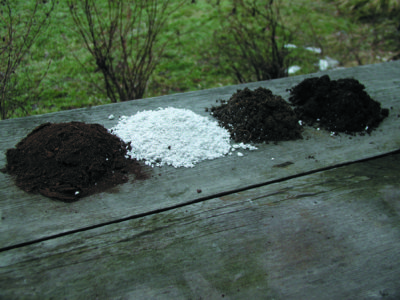
Peat, perlite, soil, and compost
Recently, however, too many weeds have been sprouting in my potting soil. Because my compost generally gets hot enough to snuff out weed seeds and because peat and perlite are naturally weed-free, these ingredients aren’t causing the problem. Garden soil in the mix is the major source of weeds.
So I cook up batches of garden soil, using the hi setting of the microwave oven for 20 minutes. My goal is to get the temperature up to about 180 degrees F., which does NOT sterilize the soil, but does pasteurize it. Overheating soil leads to release of ammonia and manganese, either of which can be toxic to plants. Sterilizing it also would leave a clean slate on which any microorganism, good or bad, could have a field day. Pasteurizing the soil, rather than sterilizing it, leaves some good guys around to fend off nefarious invaders.
After the soil cools, I add it to the other ingredients, mix everything up thoroughly, and shake and rub it through ½ inch hardware cloth mounted in a frame of two-by-fours. This mix provides a good home for the roots of all my plants, everything from my lettuce seedlings to large potted fig trees.
Blueberry Webinar
Blueberries, as usual, are bearing heavily this year, with over 60 quarts already in the freezer and almost half that amount in our bellies. After years of growing this native fruit, it has never failed me, despite some seasons of too little rain, some of too much rain, late frost, or other traumas suffered by fruit crops generally.
All of which leads up to my invitation to you to come (virtually) to my upcoming Blueberry Workshop webinar. This webinar will cover everything from choosing plants to planting to the two important keys to success with blueberries, pests, harvest, and preservation. And, of course, there will be opportunity for questions. For more and updated information, keep and eye on www.leereich.com/workshops, the “workshops” page of my website.
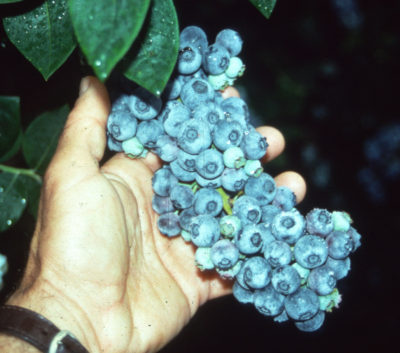

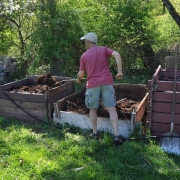
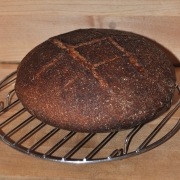

I am so fortunate to know a gal who raises guinea pigs on shavings. I get 2-3 big (lawn & leaf size) bags every 4-6 weeks. Great stuff!
Wow. That’s a lot of poop from such small animals.
Lee – I have not been as diligent as yourself to
‘construct” compost piles that generate hi temps, but rather fill bins over the course of the year as I weed and pull spent crops. I now realize that this has been a significant source of weed seed in my farmden. Some I don’t mind (dill, lettuce). But others are a royal bane – purslane first and foremost. Thus, I am now sending my “weedings” to our city-run composting plant. All this to set up my question – what are your thoughts on “commercial” composts, such as composts available from municipal run systems?
I think a lot commercial composts are quite good now. If they are good, they usually have had their composts tested, and they share their test results.
I have been adding 5 gallons of spent mash from our local brewery to my large compost pile every month, and it really speeds up the process . I scoop out a depression and add the mash, covered with fresh green grass clippings and top off with dirt.
I add mash from a friend who brews to my compost pile. One batch had been dry hopped with Cascade hops that were seedy. I have hops vines growing everywhere now.
Whoops. That could/will be a problem it they are left to grow unfettered.
It is a problem and has been for years. I now pull all the vines and let one grow every year. The worst part is the stems that slash you when pulling.
To control spread of disease through compost, and later soil, should I microwave the suspicious plant materials (eg leaves with powder mildew) on hi for a few minutes before putting them into the compost pile? Would this reduce the need to pasteurize soil or finished compost?
Thanks for your advice, Lee.
Wilma
It is some combination of time and temperature that kills weed seeds and pests. More time and less temperature or less time and more temperature. By the time compost is finished of these things will be done in.
Thanks Lee. How about for powder mildew and tomato blights? Would it help if I microwave them before adding the material to my composting bins? I live in an apartment and compost on my densely-planted balconies. I use a vermicompost bin, several bokashi fermentation buckets, and a couple of “soil factories”.
I just add everything to my compost pile without any pre-treatments.
Thanks Lee. I guess the fungi and blight sources must be ubiquitous and so plant choice is more important than pretreating the compost ingredients. Is my understanding correct?
Based on your advice, I’ll just compost my green clippings and use the bokashi to precompost only my table scraps.
Not sure what you mean in the first paragraph. Fungi and blight sources are not ubiquitous, but generally eliminated during the composting process. That’s why I feel comfortable adding everything, diseased or otherwise to my composts. As I wrote previously, time and temperature does them in.
Thanks Lee for correcting my understanding. It’s much clear to me now.